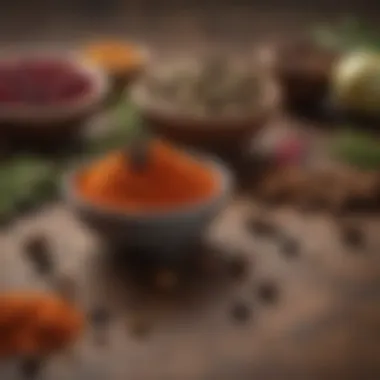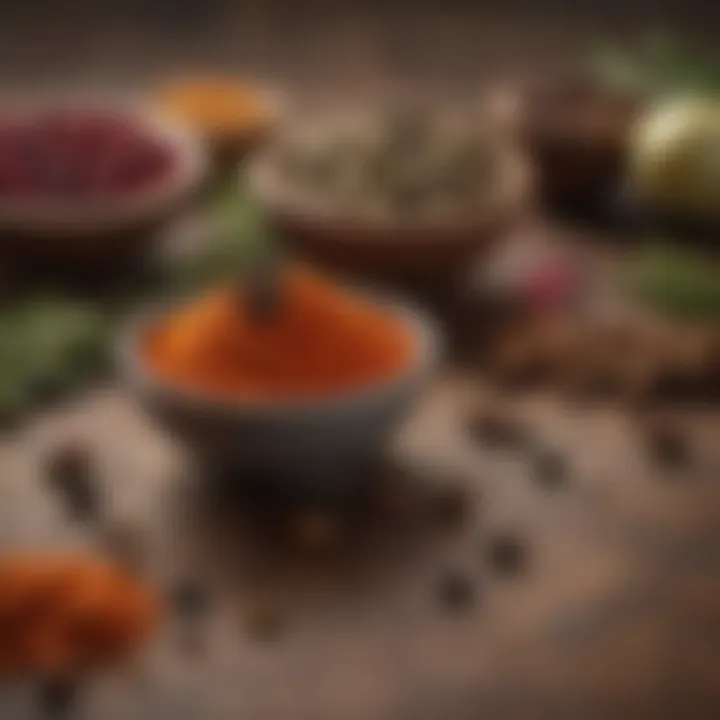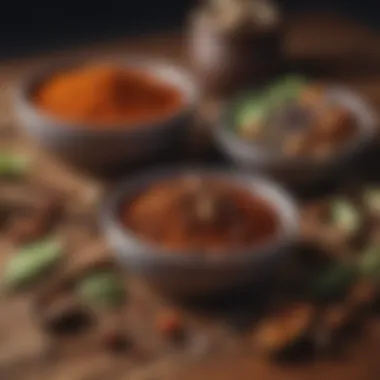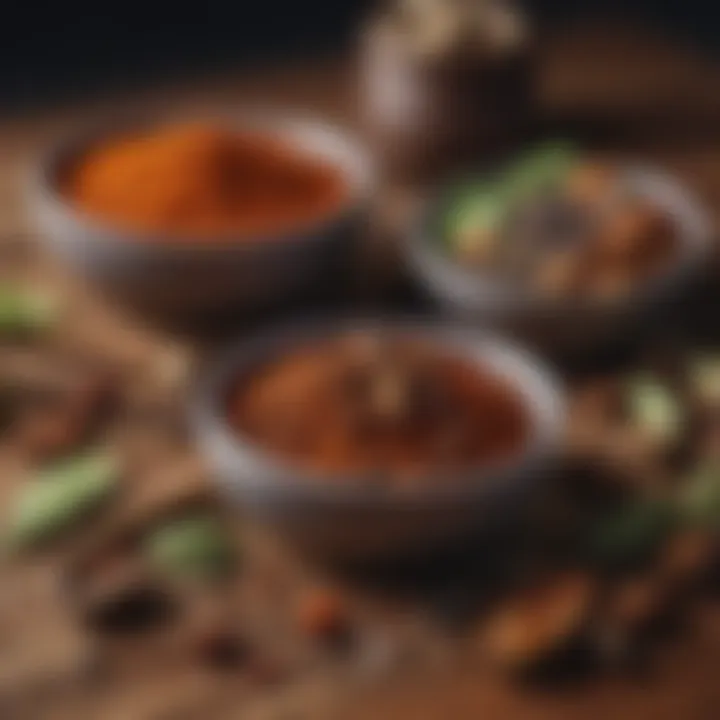The Impact of Spices on Blood Pressure


Intro
Understanding the subtle dance between what we eat and our health can sometimes feel like navigating through a maze. It's often surprising how something as simple as a sprinkle of spice can wield such power over our bodies. Among the many culinary treasures, spices stand out for their potential health benefits, particularly regarding blood pressure management, which is a pressing concern for many individuals today.
High blood pressure, often lingering unnoticed, can set the stage for more severe conditions, making the exploration of dietary factors crucial. Enter the world of spices: from the fiery heat of cayenne to the cooling benefit of turmeric, these natural flavor enhancers are getting more recognition in our quest for wellness. This article delves into the intricate relationship between certain spices and blood pressure levels, shedding light on how they not only flavor our meals but may also influence our overall health.
Throughout this piece, we will unpack the specific spices that have shown promise in studies related to hypertension, dive into the underlying mechanisms that could explain their effects, and consider how these culinary ingredients find their way into our cultural practices.
With a clear understanding of the spices’ impact and practical tips on their incorporation, readers will be equipped to make informed choices, potentially leading to improved health outcomes and flavorsome dishes that are as beneficial as they are delicious.
Understanding Blood Pressure
Understanding blood pressure is crucial not only for those monitoring their health but also for anyone invested in their well-being. It's not just a number that pops up on a screen; it represents an intricate balance between cardiovascular health and overall wellness. Knowing what blood pressure means provides insight into how spices, nutrition, and lifestyle choices can either support or hinder one's health journey.
What is Blood Pressure?
Blood pressure refers to the force of blood pushing against the walls of arteries as the heart pumps it around the body. This measurement consists of two figures: systolic pressure, which occurs when the heart beats, and diastolic pressure, which happens when the heart rests between beats. To illustrate, if someone has a blood pressure reading of 120/80 mmHg, it reflects a systolic pressure of 120 and a diastolic pressure of 80. It's a simple yet powerful number.
High blood pressure, or hypertension, often sneaks up without any noticeable symptoms. It can lead to significant health issues like heart disease, strokes, and kidney problems. Understanding these numbers is the first step to managing one’s health effectively.
How Blood Pressure is Measured
Measuring blood pressure typically involves using a sphygmomanometer, a device that wraps around the upper arm. The cuff inflates to restrict blood flow, then gradually deflates while a healthcare provider listens with a stethoscope for the distinct sounds of blood flow returning—this is called the Korotkoff sounds.
In today’s world, many people prefer automated devices for ease and convenience. Either way, accuracy is key. It’s important to take multiple readings at different times and to consider various factors such as stress, physical activity, and recent meals. All these factors affect blood pressure. Incorporating this knowledge along with the impact of spices forms a compelling picture of health management.
Importance of Maintaining Healthy Blood Pressure
Maintaining healthy blood pressure is pivotal for several reasons. High blood pressure can silently wreak havoc on the body, leading to chronic conditions and, in worst-case scenarios, premature death. Therefore, vigilance is essential.
Engaging in a healthy lifestyle, including a well-balanced diet enriched with various spices, can promote not only good cardiovascular health but also enhance overall quality of life. Spices such as turmeric or cinnamon may help in maintaining healthy blood pressure levels. Dietary choices, along with regular check-ups, can ultimately empower individuals to take control of their health.
The following aspects underscore the significance of healthy blood pressure:
- Reduction of Risk Factors: Maintaining optimal blood pressure can significantly lower the chances of heart diseases, strokes, and other cardiovascular issues.
- Enhanced Well-Being: Individuals with normal blood pressure levels often report higher energy levels, better mental clarity, and improved physical performance.
- Long-Term Health Benefits: Effectively managing blood pressure can lead to longevity and a better quality of life in later years.
"An ounce of prevention is worth a pound of cure." - Benjamin Franklin
This investment in health, through understanding and managing blood pressure, will pay dividends not just today but for years to come.
The Science of Spices and Health
The intricate relationship between spices and health has always been a topic of deep inquiry. Not only do spices enhance the flavor of our food, but they also pack a nutritional punch that can contribute to well-being. Understanding the science behind spices helps us decode their potential benefits and the roles they play in our health, particularly regarding blood pressure management. With so much focus on diet these days, it’s crucial to sift through the information and find what truly matters.
Nutritional Components of Spices
When we consider spices, we need to take a good look at their nutritional components. Spices are more than just flavor enhancers; they come with a variety of vitamins, minerals, and antioxidants. For instance, turmeric contains curcumin, which has been extensively studied for its anti-inflammatory properties. On the other hand, cinnamon is rich in polyphenols, known to improve insulin sensitivity. Not to mention, many spices like garlic contain allicin, which may have a positive impact on blood vessel health.
Here are a few notable nutritional components in spices:
- Vitamins and Minerals: Many spices are high in essential vitamins like Vitamin C (found in chili peppers) and various B vitamins.
- Antioxidants: Compounds that help combat oxidative stress in the body. For example, oregano packs a hefty dose of antioxidants.
- Essential Oils: These are responsible for the distinct aroma and flavor of spices. Clove oil, for instance, has been shown to have anti-inflammatory and antimicrobial effects.
Spices and Their Chemical Compounds
Diving deeper, spices are loaded with unique chemical compounds that influence our health in various ways. These compounds are often responsible for the specific health benefits attributed to each spice. For example, capsaicin in cayenne pepper not only gives it its heat but also has been shown to improve circulation and potentially lower blood pressure through vasodilation.
Key chemical compounds include:
- Curcumin: This is found in turmeric and is praised for its anti-inflammatory properties.
- Piperine: From black pepper, which has potential benefits for nutrient absorption and could enhance the effects of other herbs.
- Gingerol: Found in ginger, known for its various health benefits including nausea relief and anti-inflammatory effects.
These compounds do not reside in isolation; they interact with our body's systems, influencing how we process food, manage stress, and, importantly, regulate blood pressure.


Historical Uses of Spices in Medicine
The story of spices is not just modern; it's rooted in ancient practices. Historical medicinal texts often cite spices as key components in treating various ailments. For example, ginger has been a staple in traditional medicine for centuries, thought to aid in digestion and reduce inflammation.
In many cultures, spices were valued not just for their taste, but also for their healing properties. In Ayurvedic medicine, turmeric is celebrated for its extensive use in promoting health and well-being.
"Spices have played a pivotal role in the shaping of civilizations, not only in culinary arts but also in holistic healing."
As we recognize the historical context surrounding spices, it becomes evident that our ancestors understood their value far beyond flavoring. They were seen as vital tools in maintaining health, something that resonates even today as science continues to explore their benefits.
Understanding the nutritional components, chemical interactions, and historical significance of spices paints a fuller picture of their role in our diet. With this knowledge, we can make informed choices about the spices we incorporate into our meals, particularly with the aim of managing blood pressure effectively.
Spices Associated with Elevated Blood Pressure
Understanding the spices associated with elevated blood pressure is crucial for anyone keen on maintaining a balanced diet and health. While spices can often elevate the flavor of meals, some may carry risks for individuals already grappling with hypertension or predisposed to it. This section illuminates the spices that warrant caution, focusing particularly on how they might interact with blood pressure levels.
Salt and Sodium-Rich Spices
Salt, the ever-present seasoning in kitchens, stands tall as the primary substance linked to high blood pressure. Sodium intake is a well-known player in the game of hypertension. Many pre-packaged spice blends or seasonings contain sodium, which can significantly impact one's blood pressure if not monitored.
- Flavor Enhancers: Many spices like garlic salt and onion salt not only enhance flavor but also sneak in extra sodium.
- Pre-packaged Seasonings: Read the labels on seasonings like taco seasoning or marinades. They often have sodium levels that can surprise even the most mindful eater.
It’s essential to remain vigilant. A sudden increase in sodium can potentially raise blood pressure, leading to a cascade of health issues. Those wishing to spice things up should instead consider using fresh herbs or low-sodium alternatives.
Cayenne Pepper: The Role of Capsaicin
Cayenne pepper is an interesting twist in this narrative. While it's often suggested that capsaicin—the compound that gives cayenne its heat—can have a beneficial impact on blood circulation, its effects on blood pressure need careful scrutiny.
Capsaicin may couple well with some individuals, promoting better circulation and possibly lowering blood pressure in the long run. But for others, the fiery sensation can lead to discomfort or even a temporary spike in blood pressure.
- Possible Benefits: Some studies mention capsaicin may help relax blood vessels.
- Caution Advised: Individuals sensitive to spicy foods should be cautious, as reactions can vary widely.
Black Pepper and Its Effects
Black pepper, often referred to as the king of spices, is another one that walks a fine line. While it is touted for its antioxidant properties and ease in digestion, there’s a nuanced conversation around its unfortunate association with elevated blood pressure.
- Piperine: This active compound has shown potential for an increase in bioavailability of nutrients, but its impact on blood pressure is mixed. Some claim it enhances absorption of certain compounds that could, in theory, help manage blood pressure levels.
- Moderation is Key: Small amounts are typically safe, but piling on the pepper in every meal could defeat the purpose of seeking health benefits.
Other Spices: A Comprehensive Overview
Several other spices end up in the conversation about blood pressure, not all featuring prominently on the health radar.
- Garlic: Often mentioned for its benefits, yet, when many people prepare it in oil or as a heavy seasoning in meals, it can inadvertently add sodium or fats.
- Mustard: Spices made from mustard seeds can be flavorful, but mustard usually holds a significant amount of sodium—a sneaky seasoning for blood pressure.
- Cinnamon: It’s one of those spices around that’s more praised for its ability to regulate blood sugar, but there are mixed opinions on its overall impact on blood pressure.
In summary, while many spices can command a place at the dining table, understanding how they play into blood pressure is critical. Carefully selecting how much and when they are used—a balance between taste and health—can lead to a more informed culinary experience that favors wellbeing.
Mechanisms of Action
Understanding the mechanisms by which spices affect blood pressure is key to grasping their potential health benefits. The relationship between dietary spices and blood pressure extends beyond simple flavor enhancement; it delves into complex biochemical pathways that influence vascular health, inflammation, and overall cardiovascular function. Knowing these mechanisms can empower you to make more informed culinary choices that positively impact your blood pressure and holistic health.
How Spices Influence Blood Vessel Function
Spices can act as natural vasodilators, which means they may help widen blood vessels, promoting better blood flow. Take garlic, for example. Fresh garlic contains allicin, a compound that not only provides the pungent flavor but also has been shown to improve endothelial function. This is the layer of cells lining the blood vessels, which plays a vital role in regulating blood pressure.
Furthermore, turmeric, with its active ingredient curcumin, has shown the potential to enhance nitric oxide production in the endothelium. Nitric oxide is known for its ability to relax blood vessels, making it easier for blood to flow and reducing the overall resistance within the vessels.
Important Points:
- Spices like garlic and turmeric improve endothelial function.
- Enhanced nitric oxide production can lead to lower blood pressure.
The Role of Inflammation in Blood Pressure Regulation


Chronic inflammation is often linked to elevated blood pressure. Certain spices are known for their anti-inflammatory properties, which can be pivotal in mitigating hypertension. For instance, ginger contains gingerol, a substance recognized for its potency in reducing inflammatory markers in the body. When inflammation is under control, blood vessels tend to function more effectively, resulting in better blood flow and reduced blood pressure.
In addition, spices such as cinnamon may also play a role in reducing inflammation by lowering levels of C-reactive protein (CRP), a common marker for inflammation. By addressing the underlying inflammation, these spices can indirectly contribute to more stable blood pressure levels.
"Managing inflammation through diet could be as crucial as lifestyle choices in controlling blood pressure."
Interaction with Other Dietary Components
The impact of spices on blood pressure doesn't happen in isolation. Their effects are compounded when combined with other dietary elements. For example, consuming omega-3 fatty acids alongside spices like cayenne pepper can amplify their blood pressure-lowering effects. Omega-3s are found in fish like salmon and have been linked to improved heart health. When these are paired with the heat from cayenne, the overall result may be a synergistic effect that lowers blood pressure more efficiently.
On the flip side, it's important to consider the potential adverse interactions. Overusing spices that are high in sodium, like certain seasoning blends, can negate the positive effects. Therefore, understanding how spices interact with other foods in your diet is crucial for maximizing their benefits.
Things to Keep in Mind:
- Combining spices with omega-3s may enhance benefits.
- Be cautious of sodium-rich spices that can raise blood pressure.
Through examining how spices work in the body, we can appreciate not only their culinary value but also their potential in maintaining healthy blood pressure levels. This understanding equips us to make smarter dietary decisions that can serve both our taste buds and our well-being.
Culinary Applications of Blood Pressure-Related Spices
In the landscape of health, what we ingest holds tremendous sway over our wellbeing. The culinary world, rich with flavors, teems with spices boasting potential health benefits, particularly in relation to blood pressure. Understanding how to integrate these spices meaningfully into our meals can be pivotal for people looking to steer towards better health outcomes.
When talking about spices that affect blood pressure, it becomes crucial to recognize their dual role as flavor enhancers and health allies. Many are packed with antioxidants, vitamins, and minerals. Their incorporation into daily meals not only adds zest but also can have a beneficial effect on our cardiovascular health. With a meaningful approach, we can explore the ways to embrace these culinary wonders into everyday cooking.
Incorporating Spices into Daily Meals
Roots of spices run deep in diverse culinary traditions, each bearing unique stories and uses. By weaving spices into daily meals, we are basically inviting a myriad of flavors and health benefits into our kitchens. Think of turmeric, commonly used in Indian cuisine, lauded not just for its rich golden hue but also for its anti-inflammatory properties—potentially a boon for blood pressure management.
An easy way to start is by considering these simple practices:
- Sprinkling some cinnamon into your morning oatmeal or yogurt can help regulate blood sugar levels, which in turn may support healthier blood pressure.
- Adding fresh ginger to stir-fries can not only enhance the flavor but also helps with circulation.
- Using garlic as a base flavor in your daily dishes is not merely about taste, as studies suggest it could aid in managing blood pressure levels.
By experimenting with various spices, you can make your meals both delectable and nutritious. Each time you make a choice at the spice rack, you harbor the opportunity to craft tastier, healthier outcomes.
Balancing Flavor and Health in Cooking
Creating a balance between flavor and health is akin to walking a tightrope. It requires thoughtful selection and mastery of spice usage. The goal is to enjoy food while reaping the health benefits associated with various spices.
It's tempting to go overboard while spicing things up, but a little often goes a long way. Here are some tips to hit the sweet spot in flavor and health:
- Start small: Introduce spices gradually into your cooking to gauge flavors and effects on your palate.
- Combine wisely: Pairing spices along with herbs can amplify flavors without the need for excessive salt or unhealthy additives. For instance, mixing cumin and coriander can add depth, subtly enhancing taste without overwhelming.
- Mind the heat: Some spices, like cayenne pepper, pack a punch. Use these sparingly, considering both taste and potential effects on blood pressure.
- Aim for variety: Embrace a colorful palette of spices. Not only does this keep meals exciting, but it also ensures a range of health benefits from various spice families.
"The use of spices in cooking transcends mere flavor; it serves as a bridge to improved health when done thoughtfully."
By using spices intentionally, we not only enhance our cooking but also cultivate a healthier lifestyle potentially benefiting blood pressure management in the long run. Mindful incorporation of spices can lead to a win-win scenario where flavor and health join forces on our plates.
Cultural Perspectives on Spices
Understanding the cultural significance of spices goes beyond mere culinary delights. Spices have woven themselves into the fabric of societies throughout history, linking cultures and communities in ways that are profound and enduring. Their importance extends into realms like health practices, rituals, and traditions, which all play a role in how we comprehend and utilize these powerful ingredients today.
In many cultures, spices are not just elevating flavors; they are part of a heritage passed down through generations. For instance, in Indian cuisine, a variety of spices like turmeric, cumin, and coriander are essential, each with its own historical roots and health benefits. Turmeric, often dubbed "the golden spice," has become renowned not only for its flavor but also for its anti-inflammatory properties. Families incorporate it into their meals as much for tradition as for wellness.
When we look to cultures in the Mediterranean, garlic and olive oil reign supreme. They are staples in so many dishes, and their health benefits are well documented. Garlic has compounds that may help in heart health, while olive oil is lauded for its ability to reduce cholesterol levels—two essential components for maintaining a healthy blood pressure.
"Spices tell the story of a community—its history, its beliefs, and its values."
Spices in Global Cuisines
The role of spices varies widely in global cuisines, adapting to local palettes and cultural practices. In Mexico, chili peppers ignite dishes with fiery heat, offering more than just flavor; the capsaicin found in these peppers is understood to promote metabolism and possibly improve blood pressure regulation. Conversely, in Asian dishes, five-spice powder, a staple of Chinese cooking, intertwines flavors of sweetness, sourness, and earthiness; it works as both a flavor enhancer and a source of potential health benefits due to its diverse spice blend.


- Latin America: Vibrant peppers and herbs elevate dishes and contribute to heart health.
- Middle East: Spices like za'atar combine several herbs which are beloved for their aromatic profiles and health benefits.
- Africa: Unique spices such as berbere blend various spices that not only enrich meals but also aid in digestion and overall wellness.
Historical Trade and Its Impact on Spices
Spices have shaped trade routes and influenced economies throughout history. The spice trade, with its long-standing heritage, altered the course of nations. For instance, the pursuit of spices like nutmeg and cloves spurred exploration, leading to the discovery of new lands and opening trade opportunities.
Countries such as Indonesia and India became pivotal in supplying spices to Europe, creating a commerce that wasn't just about flavor but also power and wealth. This historical context gives spices a notable stature—they result from centuries of global interactions, power dynamics, and even conflicts.
The fascination with spices continues to resonate in modern society. Culinary enthusiasts embrace these elements not just for their flavors but also for their rich historical narratives. Choosing spices in today’s kitchen can be seen as participating in a global legacy that champions health and well-being while paying homage to cultural identities.
Research Insights on Spices and Blood Pressure
Understanding how spices affect blood pressure isn't just a culinary curiosity; it's a vital area of research that intersects with health, nutrition, and well-being. With rising concerns around hypertension, especially in our fast-paced world, insights from current studies can guide not only how we cook but also how we plan our diets. This segment of the article takes a closer look at recent studies and findings, shedding light on the complex relationship between spices and blood pressure management.
Recent Studies and Findings
Recent research has unveiled some intriguing connections between spices and blood pressure regulation. For instance, studies indicate that certain spices may hold the potential to decrease hypertension through various pathways.
- Turmeric, a spice well-known for its earthy flavor, contains curcumin, which some studies suggest may have a positive influence on blood pressure levels. Research published in journals indicates that curcumin can promote vasodilation, a process that helps blood vessels relax and widen, reducing blood pressure.
- Garlic, often used in various cuisines, has been highlighted in many studies for its role in managing blood pressure. Active compounds in garlic, particularly allicin, can improve endothelial function and lower arterial stiffness. Meta-analyses show a significant reduction in blood pressure among individuals consuming garlic supplements versus placebos.
- Ginger is another spice gaining attention. Some studies have suggested that ginger may help lower blood pressure through its anti-inflammatory properties and by improving blood circulation, although further research is needed to conclusively establish these effects.
Research suggests that adding spices like garlic and turmeric to our meals may lead to tangible health benefits, particularly for those looking to manage their blood pressure levels.
By synthesizing the data across different studies, it's clearer that incorporating these spices into daily diets could provide a natural adjunct to conventional blood pressure treatments. However, more studies are needed to fully appreciate the nuances of their effects and appropriate dosages for optimal benefits.
Future Directions in Spice Research
Looking ahead, the landscape of spice research concerning blood pressure is ripe for exploration. As our understanding deepens, several avenues appear promising:
- Personalized Nutrition - Research may focus on how individual responses to spices vary based on genetics and existing health conditions. This could lead to tailored dietary approaches, optimizing spice utilization for better health outcomes.
- Synergistic Effects - Investigations into how spices work alongside other dietary components might unearth significant insights. There’s potential that certain spices could enhance the effects of foods high in potassium or magnesium, both known for their blood pressure-lowering effects.
- Longitudinal Studies - More extended observational studies could help clarify the long-term effects of spices on blood pressure. Tracking diverse populations over time may highlight consumption patterns that correlate with better cardiovascular health.
- Mechanistic Studies - Future research could investigate the underlying mechanisms by which spices impact blood pressure more deeply. Understanding how compounds like curcumin or allicin function at a cellular level could help manufacturers and health professionals optimize dietary recommendations.
Practical Considerations and Recommendations
When discussing the relationship between spices and blood pressure, it’s paramount to steer clear of the temptation to see spices as a one-size-fits-all solution. Rather, understanding how to apply them judiciously can cultivate not just flavor but also health in our diets. This section emphasizes two critical considerations: moderation in spice consumption and the necessity for consultations with health professionals. Both facets are essential in navigating this flavorful landscape effectively.
Moderation in Spice Consumption
Less is often more. While spices can offer various health benefits, it's crucial to remember that moderation is the key. The potential for spices to influence blood pressure doesn't come neatly packaged; overindulgence can lead to unwanted effects. For example, salt-rich spices could increase sodium levels in the body, which is a well-known trigger for elevated blood pressure.
- Know Your Limits: It might be tempting to add generous splashes of cayenne pepper or shakes of black pepper into dishes if you enjoy their taste, but excessive consumption can backfire. Instead, consider using smaller amounts while gradually increasing them as you monitor how your body responds.
- Balance with Other Ingredients: When preparing meals, think about balancing spices with other healthy ingredients such as vegetables, whole grains, or lean proteins. This not only spreads out the flavor but also helps to maintain overall health.
"Too much of even a good spice can lead to complications. Balance is the spice of life, so to speak."
Consultation with Health Professionals
With the intricate relationship between spices and blood pressure, it’s wise to seek guidance from health professionals, particularly if you have existing health conditions. Their insights can pave your way towards making informed choices and adapting your diet effectively.
- Personalized Advice: Every individual’s body reacts differently to dietary components. A healthcare provider or a registered dietitian may provide tailored advice based on your unique health profile, including conditions like hypertension or other cardiovascular issues.
- Monitoring and Adjustments: Consulting with health professionals allows for ongoing monitoring. If you introduce a new spice or significantly alter your diet, having professional oversight ensures that adjustments can be made promptly. This proactive approach can prevent any adverse effects on blood pressure and overall health.
Culmination
In wrapping up our exploration of spices and their impact on blood pressure, it’s paramount to reemphasize the symbiotic relationship between what we consume and our health. Understanding how specific spices can influence blood pressure is not just about managing health conditions; it’s an opportunity to enhance our culinary experiences while being mindful of wellness.
Summary of Major Points
Delving deeper into the link between spices and blood pressure, several key observations emerge:
- Diverse Effects: Spices can have both positive and negative effects on blood pressure. For instance, while salt and sodium-rich spices can elevate blood pressure, others like turmeric or garlic may help in reducing it.
- Mechanisms in Play: The physiological mechanisms through which spices act on our bodies can range from influencing blood vessel function to interacting with various dietary components that either inhibit or exacerbate hypertension.
- Culinary Influence: Our choices in the kitchen not only flavor our food but also play a crucial role in our overall health. Understanding how to balance deliciousness with health is fundamental.
- Cultural Significance: Spices carry historical and cultural weight, linking us to culinary traditions while simultaneously serving as tools for health.
By summarizing these points, we can appreciate that the relationships between spices and blood pressure are complex but navigable with informed decisions.
The Importance of Informed Culinary Choices
When it comes to our health, knowledge is the seasoning that elevates flavor to health. Making informed culinary choices means:
- Selecting Wisely: Choosing spices based on their health properties can have profound impacts. Opting for spices like cinnamon or ginger, known for their antihypertensive properties, could be beneficial.
- Moderation is Key: While spices can enhance meals, moderation is crucial, especially with those linked to increased blood pressure. This calls for a balanced approach to spice use in everyday cooking.
- Educating Others: Sharing knowledge about the benefits and risks associated with spices can foster a community driven by health-conscious choices. This could be particularly important for parents aiming to guide their families toward better eating habits.
Spices can be more than merely flavors; they can be powerful allies in maintaining healthy blood pressure and overall well-being.

